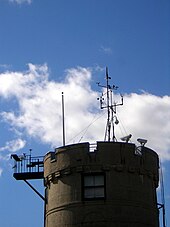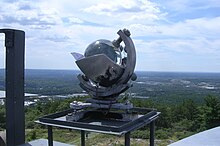Blue Hill Meteorological Observatory
| Blue Hill Meteorological Observatory | ||
|---|---|---|
| National Register of Historic Places | ||
| National Historic Landmark | ||
|
The observatory seen from the east |
||
|
|
||
| location | Milton , Massachusetts , United States | |
| Coordinates | 42 ° 12 ′ 13 ″ N , 71 ° 6 ′ 51 ″ W | |
| Built | 1885 | |
| architect | Arthur Rotch , George Tilden | |
| Architectural style | Late Gothic Revival | |
| NRHP number | [1] 80000665 | |
| Data | ||
| The NRHP added | September 25, 1980 | |
| Declared as an NHL | December 20, 1989 | |
The Blue Hill Meteorological Observatory (also referred to as the Great Blue Hill Weather Observatory , Blue Hill Weather Observatory and Blue Hill Observatory ) is located in the city of Milton in the state of Massachusetts of the United States and is home to the oldest weather station in North America . The observatory is located 635 ft (193.5 m ) elevation approximately 10 mi (16 km ) southwest of Boston on the highest point of Great Blue Hill at the junction of Interstate 93 and Massachusetts Route 138 . In the 1890s, scientists first explored the free atmosphere here with the help of weather kites . In the 1930s they developed the American version of the radiosonde .
The observatory is still in operation today and is the only American institute of its kind to have weather records that are more than 100 years old. It is therefore a major monument to the science of meteorology in the United States.
history
The Blue Hill Meteorological Observatory was founded in 1884 by the American meteorologist Abbott Lawrence Rotch and quickly assumed a leading role in the development of the then novel science of meteorology. It was the site of the first scientifically based measurements of weather conditions in the upper atmosphere, using kites to transport the measuring instruments to the desired altitude. Knowledge of wind speeds , air temperatures and relative humidity at different heights quickly became important elements for predicting future weather developments on the basis of the techniques developed at the observatory. As early as 1895, predictions could be made with remarkable accuracy in this way. During the New England hurricane in 1938, the observatory's instruments indicated wind speeds of up to 299 km / h - to date, no stronger winds have been recorded during a hurricane .
Location
By the time Rotch graduated from the Massachusetts Institute of Technology in 1884 , he had detailed plans to build an observatory on top of Great Blue Hill. Around the hill was in the 1890s, the 6,000 acres (24.3 square kilometers) comprehensive reserve Blue Hills Reservation established that from today Massachusetts Department of Conservation and Recreation is managed.
Rotch chose this location because, at 635 ft (194 m) in height, it offered the highest point within a 10-mile radius on the Atlantic Ocean and south of Maine . The observatory was founded as a weather and research station. The exposed location gave the first scientists the then unique opportunity to record weather data in its full range and to experiment with measuring instruments.
The building was completed at the end of 1884 so that the first regular observations could begin on February 1, 1885. Rotch became the first director of the observatory and held it at his own expense until his death in 1912. He bequeathed his life's work along with an endowment of 50,000 US dollars of Harvard University . If you look at inflation only , that equates to $ 1,360,000 today.
building
First half of the 20th century
The construction work, which Rotch financed from its own resources, began in 1884 and was carried out by the Rotch & Tilden architectural office , whose partner was his brother Arthur Rotch (1850-1894). The building initially consisted of a two-story tower with an adjoining house, which contained two bedrooms, a dining area and a kitchen. A two-story east wing was added in 1889 to provide more space for research and a library. In 1902 the two-story west wing followed, in which a new library and additional workplaces were set up. The roof, made of tambourine- shaped vaulted tiles, was built using a high-strength mortar developed by Rafael Guastavino , whose company also carried out the construction work.
The natural stone of the hill was used for the construction of the building , while copper plates were used for the roof . In 1905 another wall and an iron fence were erected around the building to protect the building, the scientific instruments and the privacy of the staff working there.
Over time it became apparent that the tower was no longer suitable for its purpose as rain penetrated and damaged equipment and records. One of the reasons for the rapid deterioration could be attributed to vibrations caused by instruments installed on masts at the top of the tower. In 1908, the tower was demolished and replaced by a three-story, reinforced new building with a height of 32 ft (10 m ) and 20 ft (6 m) diameter. Concrete was chosen as the building material in order to achieve maximum stability and durability - especially in strong winds. The roof of the tower is provided with battlements and a cornice with tooth cut . The windows have double frames and a slightly recessed arch decorates the first two floors.
It was only with this new tower that permanently weather-resistant and vibration-free conditions were made available, which are necessary for accurate measurements. The director's office is on the first floor, while the weather bureau is on the second floor. On the top level there is a laboratory and access to the roof, where a variety of anemometers and other meteorological instruments are installed. The measuring devices used at the observatory still include barometers and other instruments from the late 19th century. Today they are mainly used to calibrate their modern counterparts in order to ensure the accuracy and integrity of the data going back to 1885.
Second half of the 20th century
In 1962 another tower was built, which is made entirely of metal and adjoins the west wing. A heliostat was mounted on it in order to capture the sun's rays and direct them via mirrors onto a laboratory table inside the observatory. It was used to conduct studies of the upper atmosphere. After a few years, the tower was no longer used, but it still stands today.
For a number of years the building's maintenance has been severely neglected. Despite the robust construction, cracks and flakes could form in the concrete in some places due to the harsh weather conditions.
In 1980 the building was named “Great Blue Hill Weather Observatory” as part of a multi-property nomination entitled “Prehistoric and Historic Resources of the Blue Hills and Neponset River Reservations and Selected Adjacent Lands” by the Commonwealth of Massachusetts in added to the National Register of Historic Places .
In 1981 the Metropolitan District Commission transferred the authority and responsibility of the observatory to the Blue Hill Weather Club, which was founded by a group of local supporters. The association is planning a restoration of the building and the establishment of a weather museum on the site. In addition, the observatory will continue to be used by the National Weather Service for the - today, however, automated - recording of weather data.
In the forecourt of the building there is a white marble stone with climate data from 1885 to 1984 engraved on it. The memorial stone is dedicated to the founder of the Abbott Lawrence Rotch observatory.
In 1989 the building was registered as a National Historic Landmark under the name "Blue Hill Meteorological Observatory".
Operation of the observatory
Under Rotch's leadership, the Blue Hill Meteorological Observatory quickly became known for its pioneering studies of the upper atmosphere. His records of the heights, directions and speeds of the clouds contributed significantly to our knowledge of them in the early years of the 20th century.
Rotch worked at the observatory until his death on April 7, 1912. Under the terms of his will, the building was transferred to Harvard University along with a capital of $ 50,000 to finance operating costs. The university operated the observatory until 1971.
Even after 1912 the observatory was operated as an active meteorological station. The observations and records of the weather development are continued to this day and thus provide today's meteorologists with a worldwide unique database.
Since these recordings were made continuously at the same location under almost unchanged environmental conditions, they provide an important basis for assessing climate change . They are of particular quality, as all other available data were influenced by changes in terms of environmental conditions and work processes as well as by repeated relocations of the respective observation station. For this reason, the National Oceanic and Atmospheric Administration designated the Blue Hill Observatory as one of a total of 26 international reference stations within the United States.
In the 1950s, a group of researchers worked at the station that used radar technology to investigate approaching thunderstorms as far as western New York in order to research the origin of lightning . They were supported by amateurs who sent their observations to the station by post. The findings from these investigations were an important basis for the development of the US weather radar program. During this time, Charles Franklin Brooks (1891-1958), who, as director of the station, was one of the few who accurately predicted the path of the devastating hurricane in September 1938, also ended his service life.
successes
Since 1885 the scientists working at the observatory as well as external researchers have documented the scientific knowledge gained at the Blue Hill Observatory in more than 900 publications. The activity of the observatory for more than 100 years contributed significantly to the further development of the science of meteorology . Daily measurements at the observatory have continued uninterrupted since the day it was commissioned in 1885, making the facility one of the oldest continuously active stations for recording weather and climate data in the United States.
See also
Individual evidence
- ^ Entry Great Blue Hill Weather Observatory in the National Register Information System . National Park Service , accessed June 22, 2016
- ^ A b Listing of National Historic Landmarks by State: Massachusetts. National Park Service , accessed August 5, 2019.
- ^ Daily Discussion and Climate Summary. ( Text file ) Blue Hill Observatory, September 21, 2010, accessed December 14, 2012 .
- ^ National Historic Landmark Nomination. (PDF; 495 kB) National Park Service , May 1, 1989, accessed on December 14, 2012 (English).
- ^ The Blue Hill Observatory. History. Blue Hill Observatory, accessed February 9, 2016 .
- ^ John H. Conover: The Blue Hill Meteorological Observatory . the first 100 years - 1885-1985. American Meteorological Society, Boston 1990, ISBN 978-0-933876-89-7 .
- ^ Astronomy and Astrophysics. Blue Hill Meteorological Observatory. National Park Service , accessed December 16, 2012 .




